This report explores the complexity of evaluating Ethereum Layer 2 solutions and delves into the economic factors that support their value proposition.
Author: Revelo Intel
Translation: DeepTechFlow
Introduction: Understanding the Economic Principles of Rollup
Ethereum's scalability roadmap is increasingly focusing on Rollup solutions, and with the continuous adoption and the anticipated EIP-4844, Ethereum Layer 2 (L2) solutions are gaining persistent importance.
However, evaluating L2 solutions is far from simple. Unlike L1 networks such as Ethereum, which have explicit sources of income from transaction fees and explicit costs from token issuance, L2 solutions bring unique valuation challenges.
This report explores the complexity of evaluating Ethereum Layer 2 solutions and delves into the economic factors that support their value proposition.
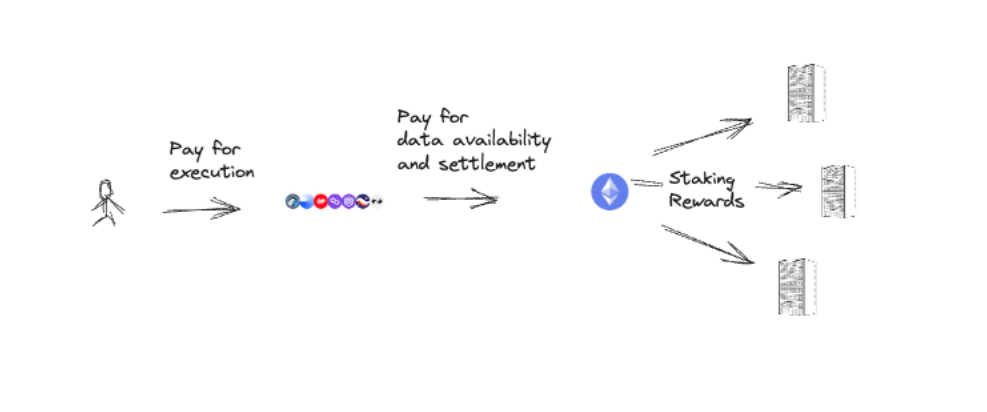
Overview
In recent years, the significant progress of Rollup solutions in the technical field cannot be ignored. Since the introduction of Rollup technology in 2018, a large amount of talent and research investment has brought significant technological advancements, including Rollup implementations equivalent to the Ethereum Virtual Machine (EVM), bridging technologies based on fraud and validity proofs, breakthroughs in batch data compression, and the launch of Rollup software development kits (SDKs). It is worth noting that various Rollup solutions such as Optimism, Arbitrum, Base, zkSync, and StarkNet have entered the market, promoting the formation of a thriving ecosystem, putting other Layer 1 solutions in a fragile and exposed position in the market share battle.
Although the current adoption rate meets expectations and proves the feasibility of attracting the next generation of users, the growth trajectory of Layer 2 solutions (L2) will accelerate in the coming months. With the upcoming EIP-4844 and the launch of new chains such as Scroll, Linea, and Base, L2 has now become the focus.
EIP-4844: Cost Tree
The upcoming Dencun upgrade brings an important feature—EIP-4844, also known as Proto-Danksharding, which signifies a significant reduction in operational costs related to Rollup. While the specific specifications of Danksharding are continuously evolving, EIP-4844 paves the way for a seamless transition of the Ethereum protocol architecture to adapt to future Danksharding implementations.
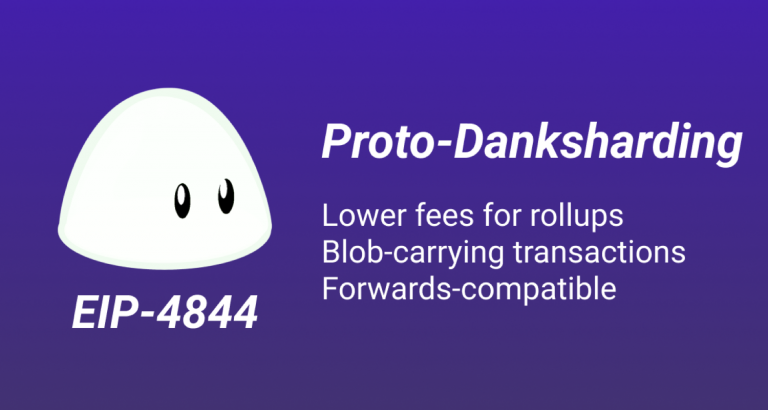
Current Rollup implementations face two major challenges. First, aggregating and submitting transaction proofs to Ethereum from L2, which processes millions of transactions daily, presents data storage bottlenecks. Second, transferring transaction data from L2s to Ethereum incurs transaction costs.

The core of EIP-4844 is the concept of "Blob" (Binary Large Object). Essentially, a blob is a data block related to transactions, distinct from regular transactions. These blob data blocks are specifically stored on the Beacon Chain and incurr the lowest gas fees. They enable Ethereum blocks to accommodate more data without increasing their size. In simple terms, using blobs can increase the amount of stored data almost tenfold compared to the average block size.
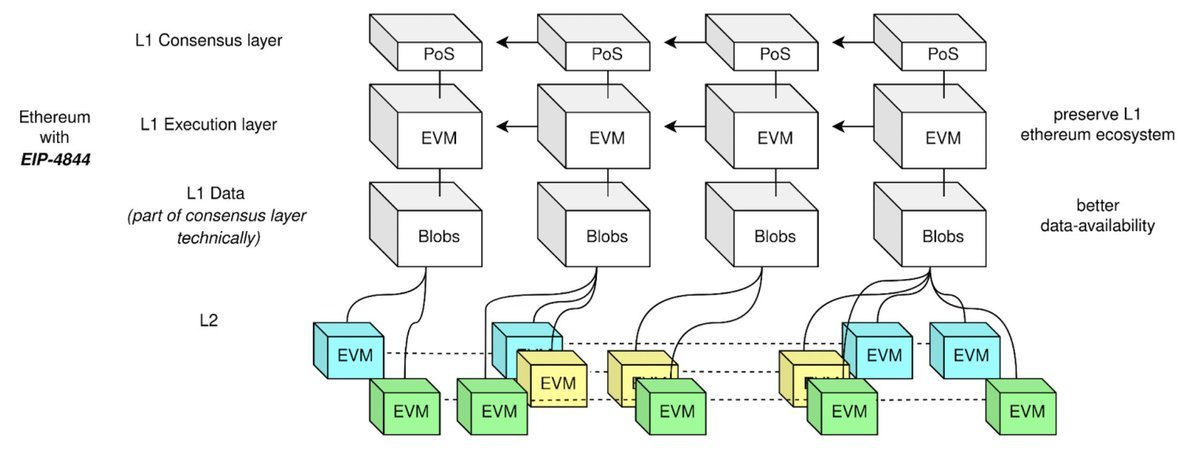
The primary purpose of blobs is to significantly reduce Data Availability (DA) costs, especially for L1 releases of Rollup. Unlike traditional methods where all Rollup data is stored in Ethereum's calldata space, blobs provide an efficient and cost-effective alternative. Since the consensus layer manages blob storage, blob transactions do not impose additional requirements on validators. Additionally, blob data will be automatically deleted within the proposed 30 to 60 days, aligning with Ethereum's pursuit of scalability rather than indefinite data storage.

Before the implementation of EIP-4844, L1 release costs accounted for over 90% of the total Rollup costs. Looking ahead, EIP-4844 introduces the concept of "data gas," a new cost category for blob transactions. This separates the cost of publishing L2 data to Ethereum from the standard gas price. With dynamic pricing based on blob supply and demand, L2 can achieve significant cost reductions when submitting its data to Ethereum, potentially reducing costs by up to 16 times, or 90% of the current gas fees.
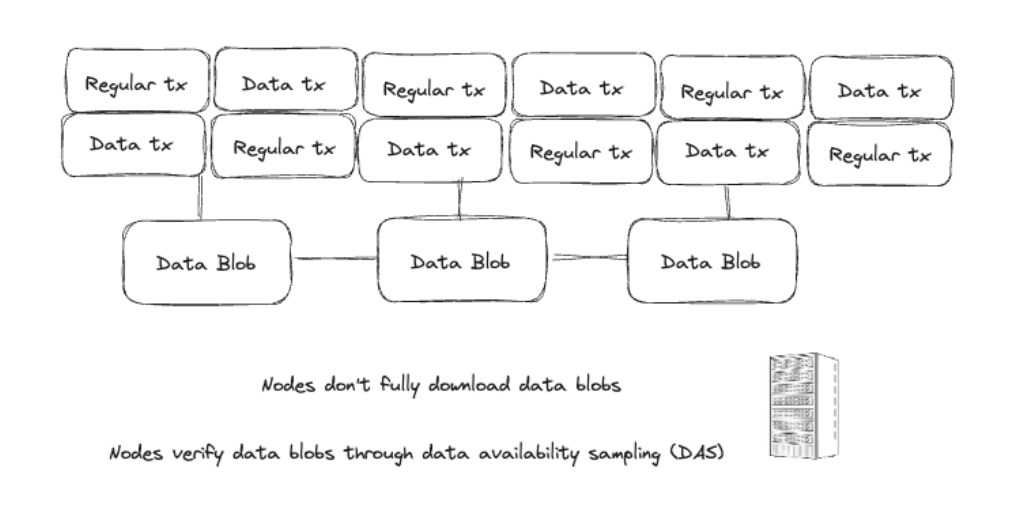
Blobs are like data blocks that make Ethereum run more efficiently. They are stored separately, do not interfere with validators, and disappear when no longer needed. This means lower costs and more data space, making Ethereum faster and cheaper.
Economics of Rollup
To understand the importance of EIP-4844, it is crucial to grasp the business model of Rollup. This upgrade significantly reduces costs, while revenue expectations may remain stable or increase with the increase in on-chain activity.
To fully understand the impact of EIP-4844 on the economic model of Rollup, a detailed analysis of their sources of income is necessary. Rollup generates income from network fees and Miner Extractable Value (MEV), with MEV currently controlled by centralized Sequencers who have a monopoly on MEV capital.
In terms of costs, Rollup faces fixed and variable costs. Fixed costs come from operations such as publishing state roots to Rollup smart contracts, validity proofs for ZK Rollup, and basic transaction fees on Ethereum. Variable costs include L2 gas fees and the L1 release fees required to store batch data on Ethereum.
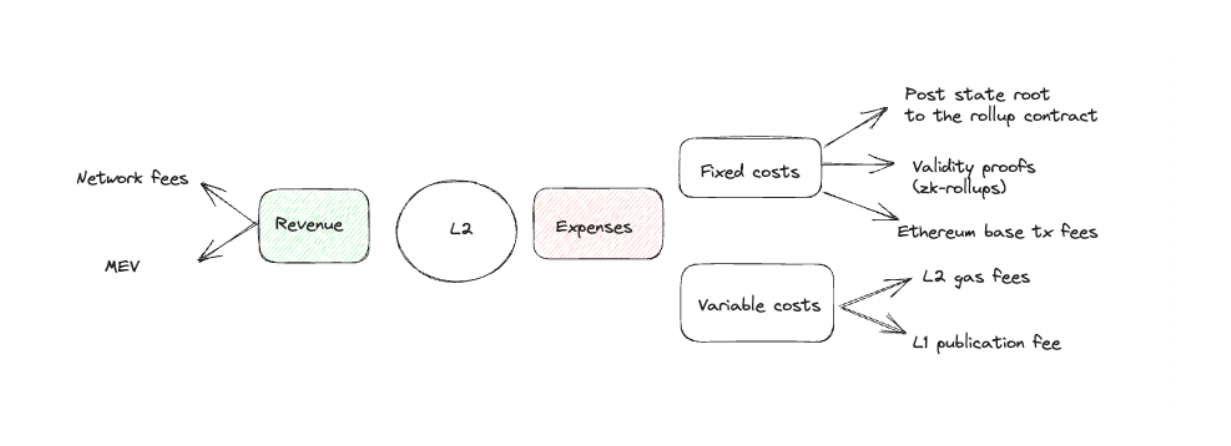
EIP-4844 introduces a dynamic blob fee system, where the fee is determined independently of block space requirements based on blob supply and demand, unlike the traditional fee model. Therefore, after EIP-4844, the fee market on Ethereum includes two dimensions:
Conventional transaction fee market based on EIP-1559: This dimension retains the existing EIP-1559 fee market for regular transactions, with its unique dynamics including base fees and priority fees in line with the principles of EIP-1559.
Blob fee market: The second dimension introduces a blob fee market, where fees are entirely determined by the current blob supply and demand. This creates an independent ecosystem different from the conventional transaction fee market, ensuring that blob fees are not affected by fluctuations in block space requirements.
An analysis of the fee market under EIP-4844 reveals several noteworthy results:
With the increase in the number of application chains and generalized L2, it is expected that the demand for blobs will gradually rise. In the event of demand exceeding the target for blobs, the price discovery mechanism of EIP-4844 may lead to an increase in data gas prices.
With the surge in demand, the cost of data gas is expected to grow exponentially. If the demand for blobs exceeds the target level, the cost of data gas will increase rapidly and exponentially, potentially increasing by over ten times within a few hours. Once the demand for blobs reaches the target price, the data gas price will exponentially increase every 12 seconds.
EIP-4844 changes the way Rollup earns and spends money. With dynamic blob fees, a part of the fee market follows conventional rules, while another part adjusts based on blob supply and demand. As the demand for blobs grows, the gas cost also rises.
Rollups as a Service
With the increase in the number of specific application chains, the Rollups as a Service (RaaS) business model is becoming increasingly important. For example, compared to specific application chains on platforms like Cosmos, Ethereum Layer 2 has a significant advantage, primarily due to the emergence of RaaS solutions.
One major reason for this advantage is the reduction in infrastructure expenses. In the context of Ethereum Layer 2, this process benefits significantly from RaaS solutions, simplifying the deployment, maintenance, and management of custom Rollups, effectively addressing the technical complexity developers often encounter when developing on the mainnet. Therefore, RaaS enables developers to focus on application layer development, enhancing their overall productivity.
RaaS also offers significant customization. Developers can choose their preferred protocol for the execution environment, settlement layer, and data availability layer, as well as flexibility in key aspects such as sequencer structure, network fees, token economics, and overall network design. This adaptability ensures that RaaS can be customized according to the specific needs and goals of a wide range of projects, enhancing the versatility of Ethereum Layer 2 solutions.
We can distinguish two main types of services:
SDK (Software Development Kit): These are development frameworks for Rollup deployment, including notable options such as OP Stack, Arbitrum Orbit for L3s, Celestia Rollkit, and Dymension RollApp Development Kit (RDK).
No-code Rollup deployment services: These services simplify the design, allowing for the deployment of Rollups without deep coding knowledge. Solutions such as Eclipse, Cartesi, Constellation, Alt Layer, Saga, and Conduit fall into this category. They lower the barriers for developers and organizations to utilize Rollup technology.
We can also include a third category for shared sequencer sets that serve multiple rollups simultaneously, such as Flashbots' Suave or Espresso.
While the current market landscape shows limited demand for custom Rollup creation, it is widely expected that as macroeconomic conditions improve and product-market fit becomes clearer, RaaS may spark the emergence of hundreds to thousands of rollups.
RaaS makes developers' work simpler, faster, and more flexible, allowing them more time to prioritize and focus on the core logic and business model of their applications.
Questioning the Utility of L2 Tokens
The success of Rollup solutions such as Optimism, Arbitrum, Mantle, and zkSync is undeniable. However, from an investment perspective, the situation becomes more complex when it comes to Rollup governance tokens, such as $OP or $ARB.
Bear Market: Limited Upside
In traditional financial markets, shareholders have a range of rights, including dividends, voting rights, and asset claims, providing stocks with intrinsic value and making them an attractive investment. In contrast, tokens that only represent governance rights lack these guarantees and are limited to voting on governance proposals. Since the income generated from transaction fees does not flow to token holders, the growth of the network does not necessarily translate into an increase in token value. This raises reasonable questions about the value proposition of Rollup tokens.
While governance rights have inherent value, especially in Layer 2 solutions where token holders have significant influence (as demonstrated by Optimism's RPGF and Arbitrum's STIP), the lack of dividends or other sources of income makes them a different form of investment.
In today's high-interest-rate environment, assets that do not provide actual returns may be less attractive to conservative investors. Rising interest rates increase the cost of capital, making the opportunity cost of holding non-income-generating assets more significant. In this context, holding ETH with stable staking rewards may be a better choice for risk-averse investors, despite the growth potential of Rollup tokens.
Bull Market: Growth Narrative
In financial markets, a company's value is not only tied to profits or dividends. For example, the valuation of growth stocks depends on their long-term growth potential and reinvestment strategy. Investing in Rollup governance tokens can also be similar to investing in non-dividend growth stocks. Historically, companies like Amazon chose not to distribute dividends but reinvested profits in expansion and innovation. Investors in such companies may not necessarily seek immediate returns through dividends; instead, they expect long-term growth and value appreciation. In the case of Optimism and the $OP token, there is a clear commitment to reinvest profits in ecosystem growth, promoting increased demand for their native dApp, sequencer revenue, and a virtuous cycle of RPGF. Additionally, with plans such as Superchain on the horizon, the bandwidth of OP Stack continues to expand, ultimately creating a strong moat that is hard to ignore due to network effects.
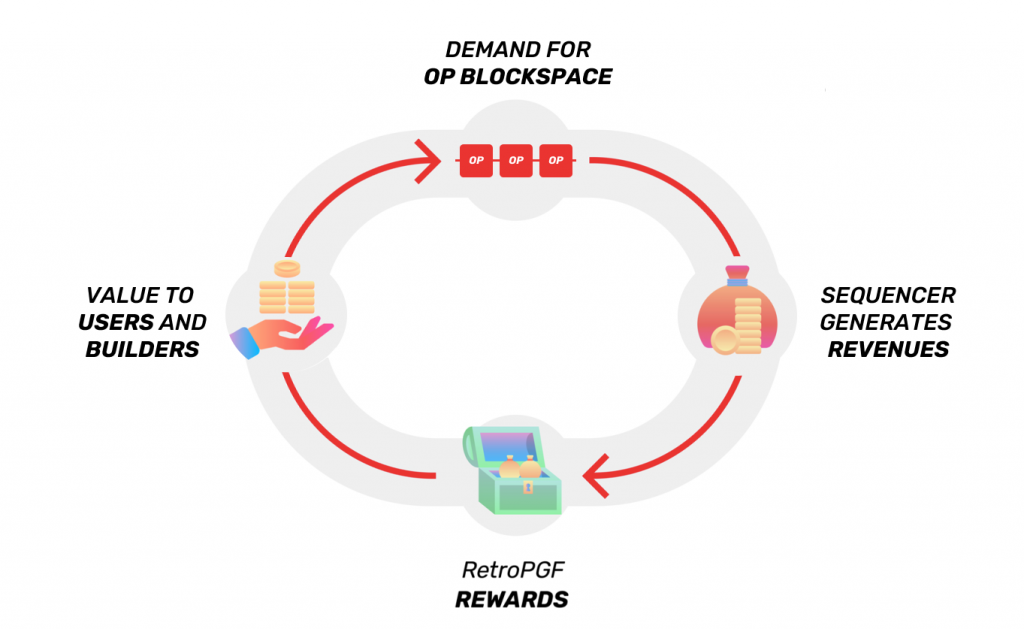
Industry Outlook
L2 is evolving into a highly competitive space, and the implicit expectations of airdrops can significantly influence user behavior within any given L2. However, it is important to recognize that the valuation of a specific L2 is inherently linked to the value of L1, and network effects are a differentiating factor.
This connection becomes evident when we examine the current operation of Rollup. They charge gas fees in the form of ETH and must pay settlement and data availability costs to Ethereum in ETH. Essentially, these rollups cannot execute their own monetary policy; Ethereum dictates how much they must pay to the underlying chain.
Therefore, L2 does not have a unique currency premium. Nonetheless, the current trading behavior of L2 tokens does not always align with this reality. However, as long as they can establish a strong ecosystem and promote network effects, these L2s have the potential to become sovereign entities in the future, and the market may seek to anticipate and capitalize on this opportunity.
Airdrops can indeed influence user behavior. However, the value of L2 is closely related to Ethereum (L1). L2 charges in $ETH and pays, so they do not have their own currency rules. In this context, the current operation mode of L2 is clear: they charge end users and retain a portion of these fees to pay for Ethereum's settlement and data availability costs. Having relevant governance tokens is essentially equivalent to holding a portion of the profit differential generated by L2.
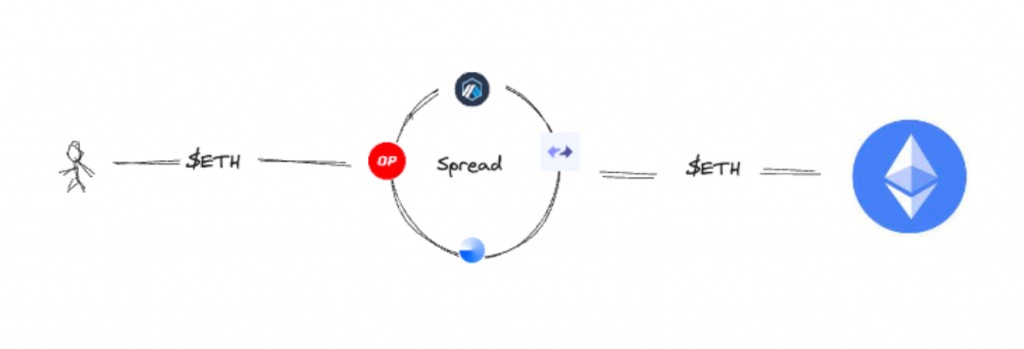
Things get more interesting when multiple instances can be created, as is the case with Optimism. In these scenarios, the profit differential generated by these instances can flow back to token holders. For example, Base allocates 10% of its fees to Optimism.
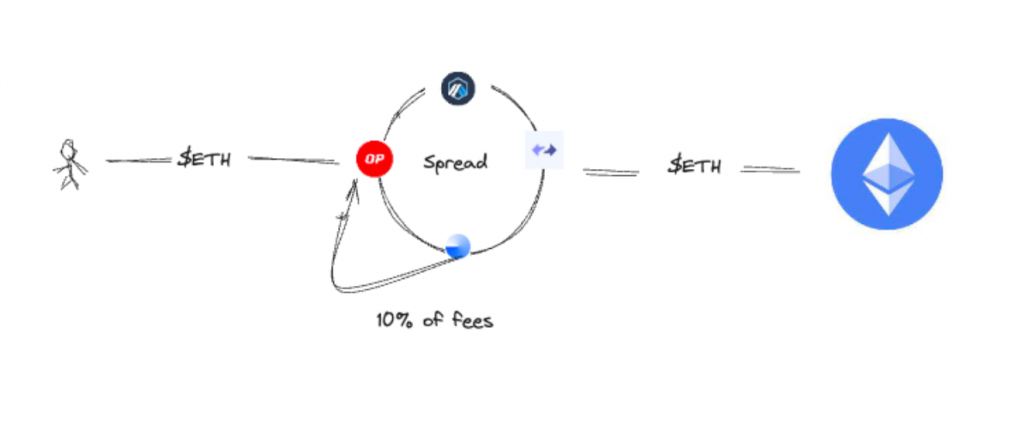
This model unlocks greater potential for the scalability of L2 assets and sets a precedent for sharing fees with other chains as an implicit authorization protocol. This dynamic not only adds depth to the L2 ecosystem but also strengthens the value proposition of L2 tokens as they continue to evolve and adapt in the competitive landscape.
Current Landscape
The current market value of Ethereum is approximately $301.4 billion, and it is expected to increase with the growth of rollups built on top of it. Additionally, the introduction of Rollups as a Service (RaaS) is expected to bring a wave of general and specific application rollups to the market.
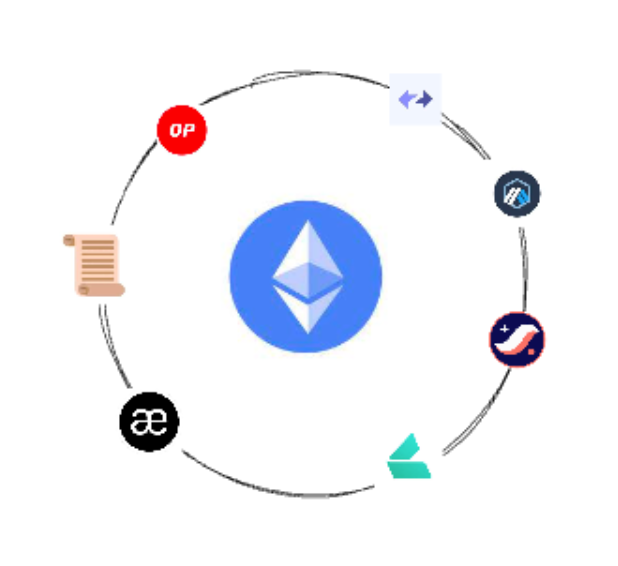
However, even though we can expect an increase in the value of the base layer, L2 typically has a higher beta value compared to $ETH. Furthermore, investors may view their tokens as a bet on the entire ecosystem. We advise caution in adopting this approach, as individual projects often shift to the latest and most popular L2 at any given time.
Furthermore, L2 is positioned to attract more users, thereby increasing the value flowing back to Ethereum. This dynamic may follow a power-law distribution, although not as pronounced as observed in liquidity staking. Therefore, it is possible that ETH is a more desirable asset for investors to hold. As more L2s enter the market and dApps eventually spread across multiple L2s, choosing the winning chain becomes more complex. However, regardless of the eventual winner, ETH holders and Ethereum validators will benefit from increased Rollup activity.
In summary:
The value of Ethereum is expected to rise with the growth of Rollup technology, and the introduction of Rollups as a Service (RaaS) will bring a wave of rollups to the market.
The volatility of L2 is different from ETH, and projects can switch between L2s quickly.
L2 will attract more users, benefiting $ETH holders and validators, but choosing a winner in L2 becomes complex.
Ultimately, holding ETH may be the safest bet.
Do We Need Other Alternative L1 Solutions?
The era of swapping transactions on L1 seems to be a thing of the past. With L2 solutions effectively addressing Ethereum's scalability challenges, questioning the value proposition of other L1 blockchains such as Near, Avalanche, Solana, Fantom, and others becomes crucial.
A key distinction lies in the ease of launching Total Value Locked (TVL). L2 has an advantage in this regard, as users and developers are already familiar with tools on Ethereum. They only need to bridge assets to the L2 chain to take advantage of reduced transaction costs. Essentially, the initial TVL on Ethereum is just looking for a more cost-effective trading environment.
However, it is important to recognize that other L1 solutions still serve specific purposes and offer unique features that may attract certain use cases.
Diverse Ecosystems: Other L1s have nurtured their own ecosystems, often with different communities, projects, and innovations. These ecosystems may cater to specific market or industry needs.
Specialized Features: Some L1s prioritize features such as high throughput, low latency, or specific consensus mechanisms. These attributes may make them more suitable for certain applications, such as high-frequency trading or gaming.
Diversification: From an investment perspective, diversifying across different L1s can reduce risk. While Ethereum still dominates, other L1s may offer diversification opportunities. For example, investing in Solana can serve as a way to counter the dominance of the Ethereum Virtual Machine (EVM) (imagine a scenario where zero-day vulnerabilities are discovered in the EVM).
L1s that can bring unique value to the ecosystem (such as Solana, Monad, etc.) will survive. Simply providing a chain compatible with EVM and lower gas fees is no longer sufficient. This now seems obvious, but in the past, there have been many instances where EVM-compatible chains with lower gas costs reached overvalued levels. For example, Moonriver, an EVM-compatible chain on Kusama (the canary network of Polkadot), reached a historical high of $494 in the fourth quarter of 2021 and is now trading at $4.
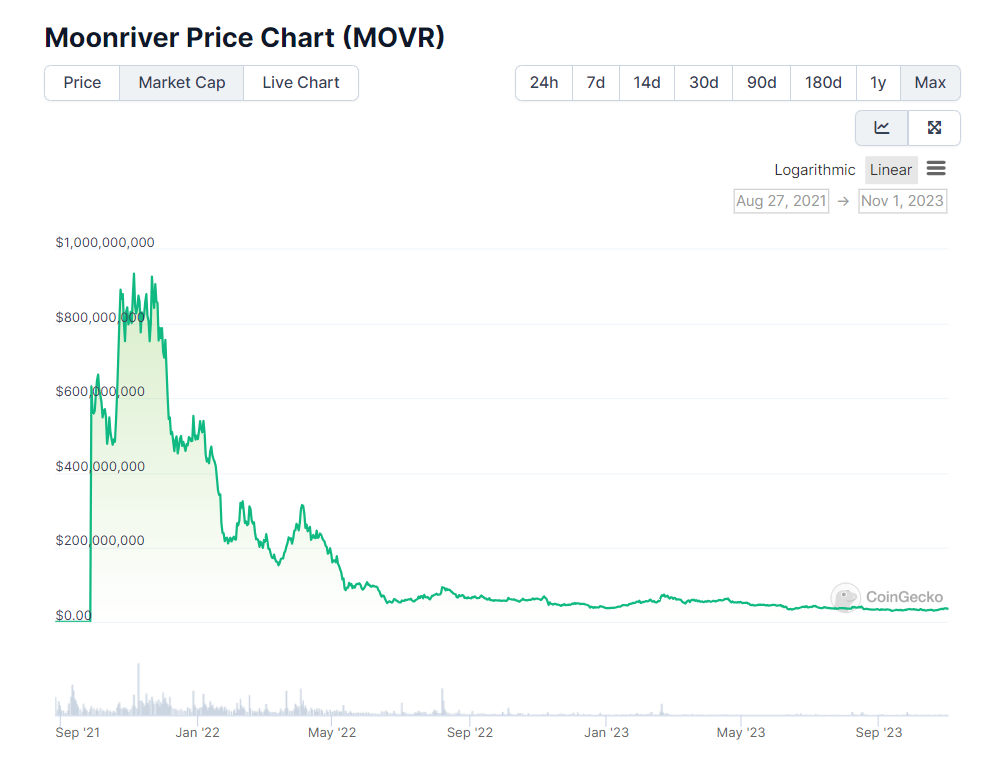
In summary:
L2 reduces the need for swapping transactions on L1. While other L1 blockchains still serve unique purposes, L2 has an advantage in Total Value Locked (TVL) as it provides familiar tools and lower transaction costs.
However, diverse ecosystems, specialized features, and diversification make other L1s attractive for specific use cases and risk mitigation.
Surviving L1s will bring unique value beyond EVM compatibility and lower gas fees.
Key Points
Traditional valuation methods are more applicable to L1, with transaction fees as revenue and token issuance as expenses. L2 presents unique challenges to valuation.
Although cryptocurrencies and stocks are structurally different, the basic investment logic still applies—investing in assets with long-term growth potential can be an attractive strategy.
L2 operates by capturing spreads, and this model is strengthened when sharing implicit revenue with other chains, such as Base allocating 10% of fees to the Optimism treasury.
ETH can be seen as an "index" asset, while L2 functions like individual "stock picks". Regardless of which L2s are most active, ETH holders and Ethereum validators will benefit from increased Rollup activity.
Conclusion
One way to approach this issue is to consider that EIP4844 will significantly reduce the cost of L2, and its revenue will increase over time. The difference between the two is the profit margin of these L2s. As this gap widens, the possibility of them starting to share these profits with token holders increases. It is a reasonable approach to consider this logic in advance if you are willing to wait for these pieces to fall into place.
As we plan the future of Rollup governance tokens like $OP or $ARB, it is clear that this space is preparing for a transformation. The rise of EIP4844, ERC4337, and the emergence of RaaS (including SDK and no-code deployment services) herald a wave of Rollup adoption.
This wave of adoption may see the rise of thousands, or even tens of thousands, of Rollups. However, there is a divergence in investors' views on the value of these governance tokens. On one hand, challenges such as the lack of traditional value capture mechanisms and the impact of a high-interest-rate environment may limit the potential upside of Rollup tokens. On the other hand, some investors may liken these tokens to non-dividend growth stocks like Google, Amazon, and Tesla, recognizing their potential for higher valuations due to long-term growth prospects.
As we enter a more competitive field, adaptability is crucial, considering the evolving dynamics and unique characteristics of Rollup governance tokens.
免责声明:本文章仅代表作者个人观点,不代表本平台的立场和观点。本文章仅供信息分享,不构成对任何人的任何投资建议。用户与作者之间的任何争议,与本平台无关。如网页中刊载的文章或图片涉及侵权,请提供相关的权利证明和身份证明发送邮件到support@aicoin.com,本平台相关工作人员将会进行核查。




